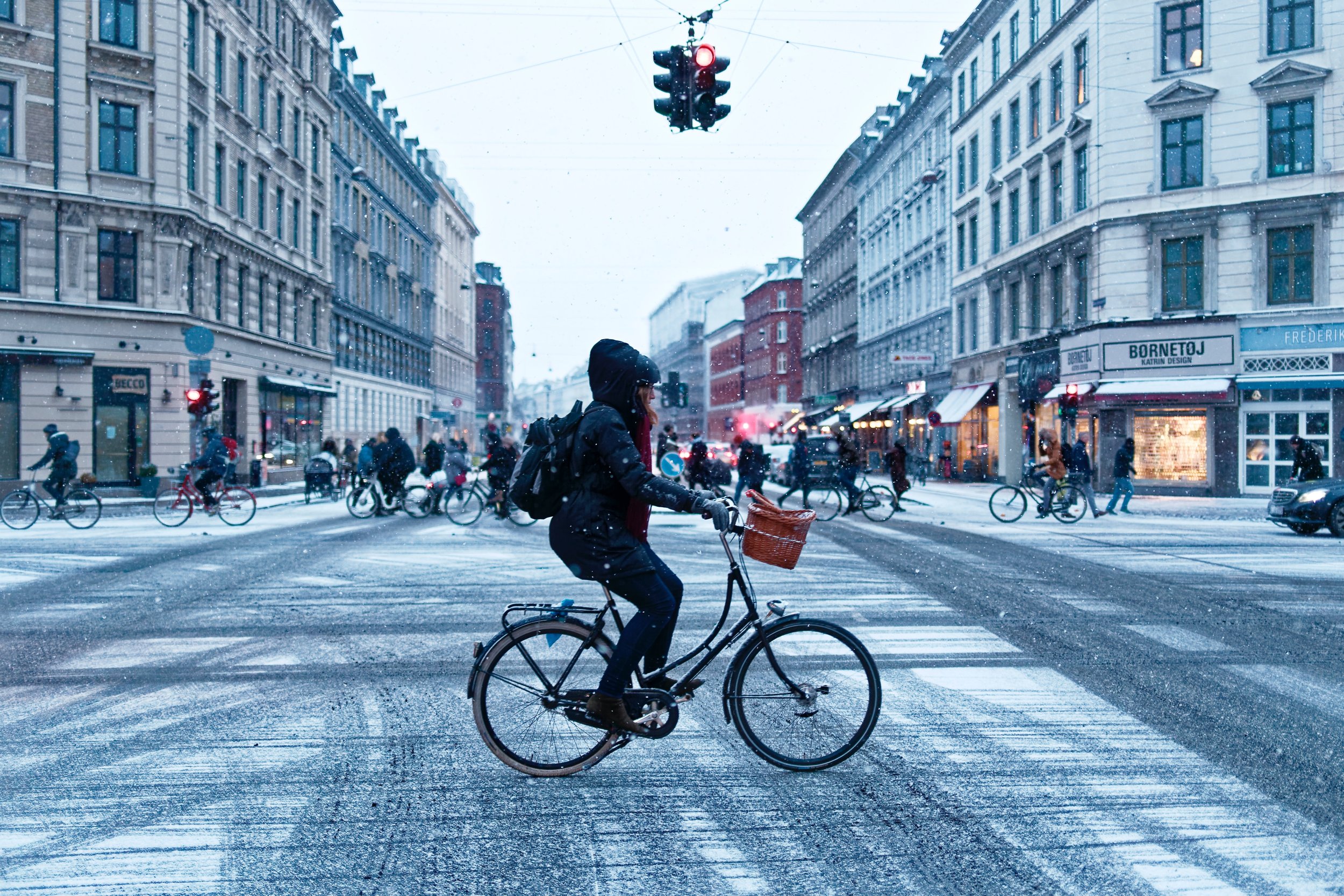BABY, IT’S COLD OUTSIDE. LET’S GO FOR A RIDE!
Photo Courtesy of The Winter Cycling Federation
Many believe that in a country like Canada, you have to give up riding during the colder, snowy weather & store your bike / electric bike over the winter months. “No way!” we say. The Winter Cycling Federation stages an International Conference each February to enlighten and advocate on a global scale. Their vision : “winter cycling for everyone - - a world where cycling year round is understood as normal and practical, where cycling is a viable transportation option for people of all ages and abilities.”
If cities focus on keeping cycling infrastructure clear of snow (in the same manner as we rally to have our sidewalks cleared for pedestrians) people will ride. And, if one is prepared to dress appropriately, and take it slow during dark and inclement conditions, winter cycling can be a breeze!
In Nordic and Scandinavian countries like Finland and Sweden, there is a massive effort to maintain and clear bike-lanes & dedicated pathways year round - some roads are even heated for optimum safety and comfort. Oulu, Finland’s success in bicycle transportation points to its potential in Canada. While Oulu’s population density is lower than that of the Edmonton metropolitan area and while its subarctic climate results in more than 160 days of snow cover per year, it has achieved cycling transportation rates (i.e. percentage of all urban trips) of 21 %, the same goes for Umeå, Sweden. Let’s not forget Copenhagen - “the world’s most bike-friendly city” (overtaking Amsterdam since 2015) where 80% of Copenhageners who bike daily, cycle through the winter.
Our friends at The City of Calgary, a winter-wonderland in its own right, have compiled a great checklist of tips for cycling at this time of year. Zygg would like to share the highlights with you:
Plan Your Winter Cycling Route
The route you take during fair weather may not be the best route in winter. Many bike lanes and sections of pathway are cleared within 48 hours of a snowfall ending, while the downtown cycle tracks are cleared within 24 hours. In Toronto, call 311 to submit a service request to clear a bike lane if there is an omission or delay.
This Pathways, Bikeways & Walkways online map shows which section The City of Toronto clears after snowfall.
There is also a real-time Road Conditions and Snow Clearing Map which shows when cycle tracks and on-street bike lanes in Toronto are plowed after a snowfall.
Test the route following a snowfall - especially if you are a commuter with important timelines - to find out how long it takes.
2. Maintain Your Bike
If you subscribe to a Zygg e-bike, the beauty is, maintenance is included. All we ask is you keep the tires pumped at the appropriate pressure and let Zygg know if there are any issues that need attention.
If you are on a personal bike / ebike, keep in mind: snow, dirt and slush can damage the moving parts of your bicycle over time. Wipe down your bike using hot water or a bicycle specific cleaning solution to wash away dirt or grime before it has a chance to settle in. If it is particularly wet and slushy out, clean your bike more often.
Keep bike parts moving with a bike grease or other lubricant. Dry lubricants will keep dirt and grime from building up. Oil-based lubricants will keep your bike functioning but they attract and accumulate dirt, so cleaning your bike more often is required. Apply bike grease/lubricant to all moving parts:
chain
pivots in the derailleur
brake levers, posts and pivots
gear shifters
cable housing ends
Bikes function best when protected from freeze-thaw conditions. Whenever possible, bring your bike /ebike into a warm area, wipe it down and let it dry completely before you ride it again.
3. Suit Up!
Dress in layers so you can adjust as needed for the morning cold, warmer afternoons and any sudden shifts in temperature.
First Layer
This layer is against your skin.
Select items that will wick moisture to keep your skin dry.
Shirts and leggings made of merino wool are a good option.
Wool or a similar material sock will keep your feet warm and dry. Keep an extra pair or two at work so you can double up as needed.
Second Layer
Select items that are breathable and warm.
A fleece or wool sweater and a light down jacket or vest will keep your upper body warm.
A pair of comfortable pants over your first-layer leggings will work for your lower body.
Third/Outer Layer
Wear a jacket that will block the wind. Those with reflective features are pretty cool.
A pair of shell pants that repel snow and slush will keep your second-layer pants dry.
Mittens with two finger sections keep your hands warm while allowing you to brake and shift gears with ease. Leather gloves or mittens over a thin fleece glove cut the wind. Better yet, if you are a commuter or bike food delivery rider, attach Pogies or Bar Mitts to your handle-bars to keep your hands ultra-protected from the wind and cold. Sweet Pete’s has them: Grab them while they are hot! They sell out quickly.
Wear a thin toque or headband under your helmet.
A neck warmer or scarf will take care of your neck/face. Gaiters are particularly good for pulling up over your nose and mouth for warmth and to make breathing easier on your lungs. 7 Mesh has one for you.
Prevent watering eyes and freezing eyelashes with a pair of sunglasses or glasses with clear lenses. Ski goggles work very well for the extra warmth and visibility they provide.
Any flat-footed winter boot, fleece-lined rain boot, hiking boot or neoprene cycling bootie will help repel snow to keep your feet dry. At specialty cycling stores, like Gears, you may also find biking “overshoes” to fit on top of your regular ones.
Winter Cycling Equipment
Tires - if cycling infrastructure is groomed properly, your regular tires should suit you fine on urban streets. Studded tires (with a knobby tread) are great for challenging winter conditions and locales. In places like Colorado, Sweden and rural Canada, they are quite popular.
Fenders - on the front and back, will keep the slush and dirt away from you.
Lights / Reflectors - are always important, however, in the dark days of winter they are a must. All Zygg e-bikes come with integrated lights and well-placed reflectors.
Bags - you may want to add a waterproof/splash-proof pannier or backpack to your routine to keep your stuff protected. Check out some options at Curbside Cycle.
Cycling Care Kits - with an extra clothing layer, an all-purpose tool for adjustments, cash or a transit pass if you want to take your bike / ebike on public transportation for part of your route, and your mobile phone to keep in touch with friends or to text/call ahead to your destination that you may be delayed, if you need to take it really “slow”.
If you do want to add features or accessories to your ride, a local shop like Bateman’s Bicycle Company has what you need.
Get outside! Have a fun, safe winter ride!


